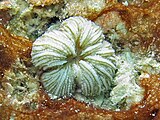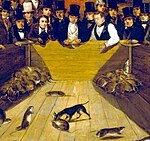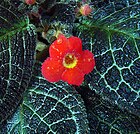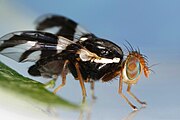User talk:Shyamal/archive31
| This is an archive of past discussions with User:Shyamal. Do not edit the contents of this page. If you wish to start a new discussion or revive an old one, please do so on the current talk page. |
June 2019 Tree of Life Newsletter
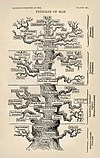
- June 2019—Issue 003
- Tree of Life
- Welcome to the Tree of Life newsletter!
|
|
|
|
| Project name | Relative WikiWork |
|---|---|
| Cats | 4.79
|
| Fisheries and fishing | 4.9
|
| Dogs | 4.91
|
| Viruses | 4.91
|
| ToL | 4.94
|
| Cetaceans | 4.97
|
| Primates | 4.98
|
| Sharks | 5.04
|
| All wikiprojects average | 5.05
|
| Dinosaurs | 5.12
|
| Equine | 5.15
|
| Bats | 5.25
|
| Mammals | 5.32
|
| Aquarium fishes | 5.35
|
| Hypericaceae | 5.38
|
| Turtles | 5.4
|
| Birds | 5.46
|
| Australian biota | 5.5
|
| Marine life | 5.54
|
| Animals | 5.56
|
| Paleontology | 5.57
|
| Rodents | 5.58
|
| Amphibians and Reptiles | 5.64
|
| Fungi | 5.65
|
| Bivalves | 5.66
|
| Plants | 5.67
|
| Algae | 5.68
|
| Arthropods | 5.69
|
| Hymenoptera | 5.72
|
| Microbiology | 5.72
|
| Cephalopods | 5.74
|
| Fishes | 5.76
|
| Ants | 5.79
|
| Gastropods | 5.8
|
| Spiders | 5.86
|
| Insects | 5.9
|
| Beetles | 5.98
|
| Lepidoptera | 5.98
|
- Spineless editors overwhelmed by stubs
Within the Tree of Life and its many subprojects, there is an abundance of stubs. Welcome to Wikipedia, what's new, right? However, based on all wikiprojects listed (just over two thousand), the Tree of Life project is worse off in average article quality than most. Based on the concept of relative WikiWork (the average number of "steps" needed to have a project consisting of all featured articles (FAs), where stub status → FA consists of six steps), only seven projects within the ToL have an average rating of "start class" or better. Many projects, particularly those involving invertebrates, hover at an average article quality slightly better than a stub. With relative WikiWorks of 5.98 each, WikiProject Lepidoptera and WikiProject Beetles have the highest relative WikiWork of any project. Given that invertebrates are incredibly speciose, it may not surprise you that many articles about them are lower quality. WikiProject Beetles, for example, has over 20 times more articles than WikiProject Cats. Wikipedia will always be incomplete, so we should take our relatively low WikiWork as motivation to write more articles that are also better in quality.
- Editor Spotlight: Showing love to misfit taxa
We're joined for this month's Editor Spotlight by NessieVL, a long-time contributor who lists themselves as a member of WikiProject Fungus, WikiProject Algae, and WikiProject Cephalopods.
1) Enwebb: How did you come to edit articles about organisms and taxonomic groups?
- Nessie: The main force, then and now, driving me to create or edit articles is thinking "Why isn't there an article on that on Wikipedia?" Either I'll read about some rarely-sighted creature in the deep sea or find something new on iNaturalist and want to learn more. First stop (surprise!) is Wikipedia, and many times there is just a stub or no page at all. Sometimes I just add the source that got me to the article, not sometimes I go deep and try to get everything from the library or online journals and put it all in an article. The nice thing about taxa is the strong precedent that all accepted extant taxa are notable, so one does not need to really worry about doing a ton of research and having the page get removed. I was super worried about this as a new editor: I still really dislike conflict so if I can avoid it I do. Anyway, the most important part is stitching an article in to the rest of Wikipedia: Linking all the jargon, taxonomers, pollinators, etc., adding categories, and putting in the correct WikiProjects. Recently I have been doing more of the stitching-in stuff with extant articles. The last deep-dive article I made was Karuka at the end of last year, which is a bit of a break for me. I guess it's easier to do all the other stuff on my tablet while watching TV.
2) Enwebb: Many editors in the ToL are highly specialized on a group of taxa. A look at your recently created articles includes much diversity, though, with viruses, bacteria, algae, and cnidarians all represented—are there any commonalities for the articles you work on? Would you say you're particularly interested in certain groups?
- Nessie: I was a nerd from a time when that would get you beat up, so I like odd things and underdogs. I also avoid butting heads, so not only do I find siphonophores and seaweeds fascinating I don't have to worry about stepping on anyone's toes. I go down rabbitholes where I start writing an article like Mastocarpus papillatus because I found some growing on some rocks, then in my research I see it is parasitized by Pythium porphyrae, which has no article, and how can that be for an oomycete that oddly lives in the ocean and also attacks my tasty nori. So then I wrote that article and that got me blowing off the dust on other Oomycota articles, encouraged by the pull of propagating automatic taxoboxes. Once you've done the taxonomy template for the genus, well then you might as well do all the species now that the template is taken care of for them too. and so on until I get sucked in somewhere else. I think it's good to advocate for some of these 'oddball' taxa as it makes it easier for editors to expand their range from say plants to the pathogenic microorganisms of their favorite plant.
- My favorite clades though, It's hard to pick for a dilettante like me. I like working on virus taxonomy, but I can't think of a specific virus species that I am awed by. Maybe Tulip breaking virus for teaching us economics or Variola virus for having so many smallpox deities, one of which was popularly sung about by Desi Arnaz and then inspired the name of a cartoon character who was then misremembered and then turned into a nickname for Howard Stern's producer Gary Dell'Abate. Sorry, really had to share that chain, but for a species that's not a staple food it probably has the most deities. But anyway, for having the most species that wow me, I love a good fungus or algae, but that often is led by my stomach. Also why I seem to research so many plant articles. You can't eat siphonophores, at least I don't, but they are fascinating with their federalist colonies of zooids. Bats are all amazing, but the task force seems to have done so much I feel the oomycetes and slime moulds need more love. Same thing with dinosaurs (I'm team Therizinosaurus though). But honestly, every species has that one moment in the research where you just go, wow, that's so interesting. For instance, I loved discovering that the picture-winged fly (Delphinia picta) has a mating dance that involves blowing bubbles. Now I keep expecting them to show me when they land on my arm, but no such luck yet.
3) Enwebb: I noticed that many of your recent edits utilize the script Rater, which aids in quickly reassessing the quality and importance of an article. Why is it important to update talk page assessments of articles? I also noticed that the quality rating you assign often aligns with ORES, a script that uses machine-learning to predict article quality. Coincidence?
- Nessie: I initially started focusing on WikiProject talk page templates because they seem to be the key to data collecting and maintenance for articles, much more so than categories. This is where you note of an article needs an image, or audio, or a range map. It's how the cleanup listing bot sorts articles, and how Plantdrew does his automated taxobox usage stats. The latter inspired me to look for articles on organisms that are not assigned to any ToL WikiProjects which initially was in the thousands. I got it down to zero with just copypasta so you can imagine I was excited when I saw the rater tool. Back then I rated everything stub/low because it was faster: I couldn't check every article for the items on the B-class checklists. Plus each project has their own nuances to rating scales and I thought the editors in the individual projects would take it from there. I also thought all species were important, so how can I choose a favorite? Now it is much easier with the rater tool and the apparent consensus with Abductive's method of rating by the pageviews (0-9 views/day is low, 10-99 is med, 100-999 is high...). For the quality I generally go by the ORES rating, you caught me. It sometimes is thrown off by a long list of species or something, but it's generally good for stub to C: above that needs formal investigation and procedures I am still learning about. It seems that in the ToL projects we don't focus so much on getting articles to GA/FA so it's been harder to pick up. It was a little culture shock when I went on the Discord server and it seemed everyone was obsessed with getting articles up in quality. I think ToL is focusing on all the missing taxa and (re)organizing it all, which when you already have articles on every anime series or whatever you can focus on bulking the articles up more. In any event, on my growing to-do list is trying to get an article up to FA or GA and learn the process that way so I can better do the quality ratings and not just kick the can down the road.
4) Enwebb: What, if anything, can ToL and its subprojects do to better support collaboration and coordination among editors? How can we improve?
- Nessie: I mentioned earlier that the projects are the main way maintenance is done. And it is good that we have a bunch of subprojects that let those tasks get broken up into manageable pieces. Frankly I'm amazed anything gets done with WikiProject Plants with how huge its scope is. Yet this not only parcels out the work but the discussion as well. A few editors like Peter coxhead and Plantdrew keep an eye on many of the subprojects and spread the word, but it's still easy for newer editors to get a little lost. There should be balance between the lumping and splitting. The newsletter helps by crossing over all the WikiProjects, and if the discord channel picked up that would help too. Possibly the big Enwiki talk page changes will help as well.
5) Enwebb: What would surprise the ToL community to learn about your life off-Wikipedia?
- Nessie: I'm not sure anything would be surprising. I focus on nature offline too, foraging for mushrooms or wild plants and trying to avoid ticks and mosquitos. I have started going magnet fishing lately, more to help clean up the environment than in the hopes of finding anything valuable. But it would be fun to find a weapon and help solve a cold case or something.
- June DYKs
|
You are receiving this because you added your name to the subscribers list of the WikiProject Tree of Life. If you no longer wish to receive the newsletter, please remove your name.
sent by ZLEA via MediaWiki message delivery (talk) 20:29, 3 July 2019 (UTC)
A glass of Thandai for you
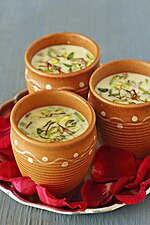 |
A glass of Thandai for you | |
| Here is a glass of Thandai for you. Thandai is a traditional Indian cold drink prepared with a mixture of almonds, fennel seeds, watermelon kernels, rose petals, pepper, vetiver seeds, cardamom, saffron, milk and sugar. Thank you. Titodutta (talk) 18:55, 28 July 2019 (UTC) |
- Thanks, is there a new script to post these Indian dishes? @Titodutta: - btw, let me know anytime you need that scanner. Still being put to use on a near daily basis. Shyamal (talk) 03:47, 30 July 2019 (UTC)
Tree of Life Newsletter

- July 2019—Issue 004
- Tree of Life
- Welcome to the Tree of Life newsletter!
|
|
|
|
|
The WikiCup, an annual editing competition, is now in its fourth round. Casliber, consistent participant since 2010 and winner in 2016, is currently dominating Group A with 601 points. Largely responsible is the successful Featured Article nomination of Masked booby. The other remaining Tree of Life participant, Enwebb, is participating in her first ever WikiCup. In this round, she has a grand total of...5 points. But with the recent Featured Article nomination of Megabat, she stands to gain 600 points if successful. As it stands, though, it appears that at least one ToL editor is headed to the fifth and final round of 8 contestants, which begins September 1. Thus far, all participants in the WikiCup have generated 17 Featured Articles, 116 Good Articles, 16 Featured Lists, and 57 Featured Pictures. The Good Article Nominations backlog has been reduced as well, with 286 Good Article Reviews. |
|
For this month's editor spotlight we're joined by Charlesjsharp, a longtime contributor to Wikimedia Commons with a plethora of featured pictures on English Wikipedia. 1) Starsandwhales: How long have you been editing Wikipedia, and how did you get interested? How did you begin your journey of photographing wildlife?
 2) S&W: Over the years, you've taken photos of many different organisms from birds to insects to big cats; you have an extensive list of favorite images. Which animals have been the most exciting for you to photograph?
3) S&W: Many articles under ToL have requests for people to add images that can go unanswered. What can the community do to improve the coverage of different organisms on Wikipedia, especially when it comes to images?

4) S&W: What advice would you give to people new to photographing wildlife?
5) S&W: What would the Tree of Life community be surprised to learn about your life off-wiki?
* An example of cumbersome code: getting the layout of my responses to your questions. So dated, and no online spellchecker. |
|
You are receiving this because you added your name to the subscribers list of the WikiProject Tree of Life. If you no longer wish to receive the newsletter, please remove your name.
Sent by ZLEA via MediaWiki message delivery (talk) 18:59, 1 August 2019 (UTC)
Administrators' newsletter – August 2019
News and updates for administrators from the past month (July 2019).
|
|
- Following a request for comment, the page Wikipedia:Office actions has been changed from a policy page to an information page.
- A request for comment (permalink) is in progress regarding the administrator inactivity policy.
- Editors may now use the template {{Ds/aware}} to indicate that they are aware that discretionary sanctions are in force for a topic area, so it is unnecessary to alert them.
- Following a research project on masking IP addresses, the Foundation is starting a new project to improve the privacy of IP editors. The result of this project may significantly change administrative and counter-vandalism workflows. The project is in the very early stages of discussions and there is no concrete plan yet. Admins and the broader community are encouraged to leave feedback on the talk page.
- The new page reviewer right is bundled with the admin tool set. Many admins regularly help out at Special:NewPagesFeed, but they may not be aware of improvements, changes, and new tools for the Curation system. Stay up to date by subscribing here to the NPP newsletter that appears every two months, and/or putting the reviewers' talk page on your watchlist.
Since the introduction of temporary user rights, it is becoming more usual to accord the New Page Reviewer right on a probationary period of 3 to 6 months in the first instance. This avoids rights removal for inactivity at a later stage and enables a review of their work before according the right on a permanent basis.
Your RM close (Cyaniris semiargus)
Hey there, I think your close at Talk:Cyaniris semiargus ended up malformed - the {{RM top}} template needs to go at the very top, just below the section header, and you need to remove or replace the {{Requested move/dated}} template. Otherwise the bot won't remove it from the list at WP:RM or remove the RM notice from the article. Also, it's quite unusual to close an RM so soon after it's opened, without any discussion having taken place. At the very least, I think it would be good to give some rationale in your closing message for why you think this qualifies for a speedy close, rather than staying open for the standard seven days. (See also WP:RMCLOSE). Cheers. Colin M (talk) 17:24, 4 August 2019 (UTC)
- @Colin M: I saw it as a non-controversial taxonomic update and I normally do these routinely as bold moves. I have added a note there. Hopefully now no longer malformed. Shyamal (talk) 02:03, 5 August 2019 (UTC)
Tree of life discussion
You just removed my reply? Chiswick Chap (talk) 07:32, 9 August 2019 (UTC)
- Oops, definitely unintended.... Shyamal (talk) 07:34, 9 August 2019 (UTC)
Mail notice

It may take a few minutes from the time the email is sent for it to show up in your inbox. You can at any time by removing the {{You've got mail}} or {{ygm}} template.
Daniel Case (talk) 16:47, 16 August 2019 (UTC)
- @Daniel Case: - responded. Shyamal (talk) 09:52, 17 August 2019 (UTC)
Page move request 26
Hello Shyamal, I would like to request a move of Yucatania sphaeroidocladus to its monotypic genus page. The genus page is currently a redirect with negligble page history. Thanks, Loopy30 (talk) 11:44, 27 August 2019 (UTC)
Page move request 27
Hello Shyamal, I would like to request a move of the monotypic class Homoscleromorpha to its order page Homosclerophorida. The order page is currently a redirect with some minor page history. Thanks again, Loopy30 (talk) 19:33, 30 August 2019 (UTC)
 Done Thanks Shyamal (talk) 22:47, 30 August 2019 (UTC)
Done Thanks Shyamal (talk) 22:47, 30 August 2019 (UTC)
Precious anniversary
| birds of India illustrated | |
|---|---|
| ... you were recipient no. 2010 of Precious, a prize of QAI! |
--Gerda Arendt (talk) 06:39, 28 August 2019 (UTC)
List of birds of India
Clements v. IOC discussion moved to Talk:List of birds of India. Shyamal (talk) 05:27, 25 August 2019 (UTC)
- Shyamal, I've finished updating the India list. Many splits and genus changes were never done. I didn't know if you wanted to look thru. I changed English names to the IOC English names, not sure if there are any local names you prefer over the IOC.....Pvmoutside (talk) 19:22, 2 September 2019 (UTC)
- Looks ok now. Shyamal (talk) 10:47, 3 September 2019 (UTC)
Page move request 28
Hello Shyamal, Could you move the article of the former order Astrophorida to its now accepted taxon of suborder (at the page Astrophorina). The destination page is currently a redirect. Similarly, could you move Spirophorida to its now accepted taxon of Spirophorina? Thanks, Loopy30 (talk) 01:25, 8 September 2019 (UTC)
You are aware...
... that the article is at this moment being read by a GA reviewer? Thanks. Chiswick Chap (talk) 10:31, 11 September 2019 (UTC)
- I saw that it has been nominated, but is there any issue if I find (and hopefully fill) some gaps in the article? Shyamal (talk) 10:34, 11 September 2019 (UTC)
- Timing not ideal, but evidently you're going to anyway. Chiswick Chap (talk) 07:38, 12 September 2019 (UTC)
- Alright, will steer clear until the review is completed. Shyamal (talk) 07:54, 12 September 2019 (UTC)
- Timing not ideal, but evidently you're going to anyway. Chiswick Chap (talk) 07:38, 12 September 2019 (UTC)
Can you help at AN
Wondering if you can be of any assistance at Wikipedia:Administrators' noticeboard#Bird Sanctuary as you seem to have dealt with this before. Especially if there are any affected pages/talk pages you're aware of that haven't been found, it would probably be useful for us to know. Nil Einne (talk) 14:45, 14 September 2019 (UTC)
- @Nil Einne: - yes, I have seen this, I thought it was a misguided editathon but I have not been able to get those editors to communicate. I guess just dealing with this the normal way with reverts will be the best course. Shyamal (talk) 15:07, 14 September 2019 (UTC)
Page move request 29
Hello Shyamal, I would like to request a move of Bradytriton silus and Nyctanolis pernix to their respective monotypic genus pages. The genus pages are currently redirects with some page history. Thanks, Loopy30 (talk) 00:23, 14 October 2019 (UTC)
 Done Shyamal (talk) 00:46, 14 October 2019 (UTC)
Done Shyamal (talk) 00:46, 14 October 2019 (UTC)
- Thanks Shyamal, could you also move Parvimolge townsendi to its monotypic genus page? The genus pages is currently a redirect with minimal page history. Loopy30 (talk) 13:13, 14 October 2019 (UTC)
Happy Diwali 2019

|
Happy Diwali!!! | |
|
Sky full of fireworks, Wishing You a Very Happy and Prosperous Diwali.
|
- @Titodutta: wishing you a happy Diwali too! Shyamal (talk) 13:26, 27 October 2019 (UTC)
Page move request 30
Hello Shyamal, a happy Diwali to you. When you are free, could you a move Pseudobufo subasper to its monotypic genus page? The genus page is currently a redirect with minimal page history. Thanks, Loopy30 (talk) 01:55, 28 October 2019 (UTC)
 Done Shyamal (talk) 03:00, 28 October 2019 (UTC)
Done Shyamal (talk) 03:00, 28 October 2019 (UTC)
- And another request - Atopophrynus syntomopus, also to its monotypic genus page. Thanks again, Loopy30 (talk) 00:59, 1 November 2019 (UTC)
use of authority control and DEFAULTSORT templates
As of October 15, 2019, for the Wikipedia page for William R. Horsfall, there is no "authority control" template and there is no "DEFAULTSORT" template. The "authority control" template creates links to various library resources and should generally be used for scientists and/or authors. The "DEFAULTSORT" template is needed to override Wikipedia's sort on the leading letters of the title page — if the "DEFAULTSORT" template is omitted, as in the case of William R. Horsfall, then the sort occurs on "William" instead of "Horsfall". Suslindisambiguator (talk) 17:55, 16 October 2019 (UTC)
- Will try to remember the DEFAULTSORT template. Shyamal (talk) 04:35, 1 November 2019 (UTC)
October 2019 Tree of Life Newsletter

- October 2019—Issue 007
- Tree of Life
- Welcome to the Tree of Life newsletter!
|
|
|
|
|
|
By request from another editor, this month I wrote an overview of ways that content is featured on Wikipedia. Below I have outlined some of the processes for getting content featured: Did You Know (DYK)What is it: A way for articles to appear on the main page of Wikipedia. A short hook in the format of "Did you know...that ___" presents unusual and interesting facts to the reader, hopefully making the reader want to click through to the article How it works: The DYK process has fairly low barriers for participation. The eligibility criteria are few and relatively easy to meet. Some important guidelines:
The process for creating the nomination is somewhat tedious. Instructions can be found here (official instructions) and here ("quick and nice" guide to DYK). Experience is the best teacher here, so don't be afraid to try and fail a few times. The last few DYK nominations I've done, however, have been with the help of SD0001's DYK-helper script, which makes the process a bit more streamlined (you create the template from a popup box on the article; created template is automatically transcluded to nominations page and article talk page) Once your nomination is created and transcluded, it will need to be reviewed. The reviewer will check that the article meets the eligibility criteria, that the hook is short enough, cited, and interesting, and that other requirements are met, such as for images. If you've been credited with more than 5 DYKs, the reviewer will also check that you've reviewed someone else's nomination for each article that you nominate. This is called QPQ (quid pro quo). You can check how many credited DYKs you've had here to see if QPQ is required for you to nominate an article for DYK. Good Article (GA)What it is: A peer review process to determine that an article meets a set of criteria. This adds a How it works: You follow the instructions to nominate an article, placing a template on its talk page. Anyone can nominate an article—you don't have to be a major contributor, though it is considered polite to inform the major contributors that you are nominating the article. The article is added to a queue to await a review. In the ToL, it seems that reviews happen pretty quickly, thanks to our dedicated members. Once the review begins, the reviewer will offer suggestions to help the article meet the 6 GA criteria. Upon addressing all concerns, the reviewer will pass the article, and voilà! Good Article! Advice to a first-time nominator: Look at other Good Articles in related areas before nominating. If you're unsure about nominating, consider posting to the talk page of your project to see what other editors think. You can also have a more experienced editor co-nominate the article with you. Featured Article (FA)What it is: An exhaustive peer review to determine that an articles meets the criteria. This adds a How it works: You follow the instructions to nominate an article, placing a template on its talk page. Nominated articles are usually GAs already. Uninvolved editors can nominate, though the article's regular editors should be consulted first. Several editors will come by offering feedback, eventually supporting or opposing promotion to FA. A coordinator will determine if there is consensus to promote the article to FA. For an editor's first FA, spot checks to verify that the sources support the text are conducted. Advice to a first-time nominator: The Featured Article Candidate (FAC) process is a bit intimidating, but several steps can make your first one easier (speaking as someone who has exactly one). If you also did the GA nomination of the article, you can ask the reviewer for "extra" feedback beyond the GA criteria. You can also formally request a peer review and/or a copy edit from the Guild of Copy Editors to check for content and mechanics. First-time nominators are encouraged to seek the help of a mentor for a higher likelihood of passing their first FAC. Good and Featured Topics (GT and FT)What it is: It took me a while to realize we even had GT and FT on Wikipedia, as they are not very common relative to GA and FA. Both GT and FT are collections of related articles of high quality (all articles at GA or FA, all lists at Featured List). GT/FT have to be at least 3 articles with no obvious gaps in coverage of the topic, along with other criteria. For GT, all articles have to be GA quality and all lists must be FL. For FT, at least half the articles must be FA or FL, with the remaining articles at GA. How it works: Follow the nomination procedures for creating a new topic or adding an article to an existing topic. Other editors weigh in to support or oppose the proposal. Coordinators determine if there is consensus to promote to GT/FT. Advice to a first-time nominator: There are very few GT/FT in Tree of Life (5 GT and 11 FT). Most of the legwork appears to be improving a cohesive set of articles to GA/FA. |
|
You are receiving this because you added your name to the subscribers list of the WikiProject Tree of Life. If you no longer wish to receive the newsletter, please remove your name.
Delivered by MediaWiki message delivery (talk) at 03:34, 3 November 2019 (UTC) on behalf of DannyS712 (talk)

